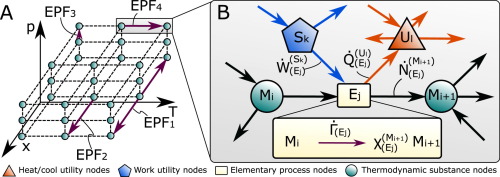当前位置:
X-MOL 学术
›
Chem. Eng. Sci.
›
论文详情
Our official English website, www.x-mol.net, welcomes your
feedback! (Note: you will need to create a separate account there.)
The FluxMax Approach: Simultaneous Flux Optimization and Heat Integration by Discretization of Thermodynamic State Space Illustrated on Methanol Synthesis Process
Chemical Engineering Science ( IF 4.1 ) Pub Date : 2020-04-01 , DOI: 10.1016/j.ces.2019.115382 Dominik Schack , Georg Liesche , Kai Sundmacher
Chemical Engineering Science ( IF 4.1 ) Pub Date : 2020-04-01 , DOI: 10.1016/j.ces.2019.115382 Dominik Schack , Georg Liesche , Kai Sundmacher

|
Abstract Resource efficiency is a key driver in the chemical industry for both economic and ecological reasons. However, often the design of chemical processes or units and the corresponding heat integration, is divided into two design phases: a flow optimization to identify an optimal design and the subsequent evaluation of the heat integration potential. This procedure cannot guarantee the identification of the global resource optimum, which increases the need for a method that can do both simultaneously. This is the aim of the FluxMax approach that discretizes the thermodynamic state space. The introduction of nodes corresponding to mixtures, elementary processes and utilities allows the representation of any chemical process as a directed graph, which decouples effectively process-based nonlinearities from the optimization problem. Heat integration is considered by additional constraints. Using the methanol synthesis process as example, energy-optimal process configurations are identified that outperform configurations identified in a sequential procedure.
中文翻译:

FluxMax 方法:通过离散化热力学状态空间同时优化和热积分,以甲醇合成过程为例
摘要 出于经济和生态原因,资源效率是化学工业的关键驱动因素。然而,化学过程或单元的设计以及相应的热集成通常分为两个设计阶段:确定最佳设计的流程优化和随后的热集成潜力评估。这个过程不能保证全局资源最优的识别,这增加了对可以同时进行的方法的需求。这是离散化热力学状态空间的 FluxMax 方法的目标。与混合物、基本过程和实用程序相对应的节点的引入允许将任何化学过程表示为有向图,从而有效地将基于过程的非线性与优化问题分离。热集成是通过附加约束来考虑的。以甲醇合成过程为例,确定了优于顺序程序中确定的配置的能量优化过程配置。
更新日期:2020-04-01
中文翻译:

FluxMax 方法:通过离散化热力学状态空间同时优化和热积分,以甲醇合成过程为例
摘要 出于经济和生态原因,资源效率是化学工业的关键驱动因素。然而,化学过程或单元的设计以及相应的热集成通常分为两个设计阶段:确定最佳设计的流程优化和随后的热集成潜力评估。这个过程不能保证全局资源最优的识别,这增加了对可以同时进行的方法的需求。这是离散化热力学状态空间的 FluxMax 方法的目标。与混合物、基本过程和实用程序相对应的节点的引入允许将任何化学过程表示为有向图,从而有效地将基于过程的非线性与优化问题分离。热集成是通过附加约束来考虑的。以甲醇合成过程为例,确定了优于顺序程序中确定的配置的能量优化过程配置。











































 京公网安备 11010802027423号
京公网安备 11010802027423号